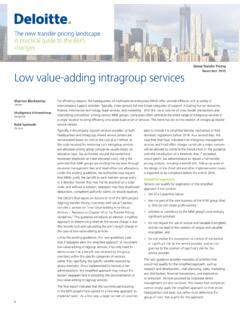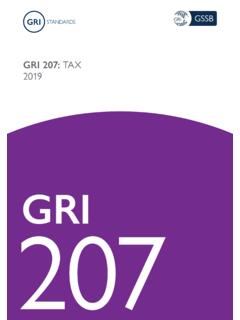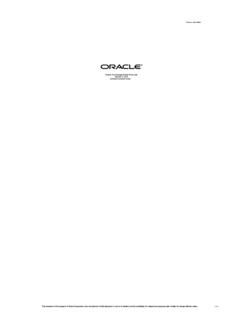Transcription of 2010 REPORT ON THE ATTRIBUTION OF PROFITS TO ... - OECD
1 ORGANISATION FOR ECONOMIC CO-OPERATION AND DEVELOPMENT 2010 REPORT ON THE ATTRIBUTION OF PROFITS TO permanent ESTABLISHMENTS 22 July 2010 CENTRE FOR TAX POLICY AND ADMINISTRATION FOREWORD This REPORT was approved by the Committee on Fiscal Affairs on 22 June 2010 and by the OECD Council for publication on 22 July 2010. The Recommendation adopted by the Council is included as an Addendum to the REPORT . 2 TABLE OF CONTENTS PREFACE .. 8 2010 REPORT ON THE ATTRIBUTION OF PROFITS TO permanent ESTABLISHMENTS .. 10 PART I: GENERAL CONSIDERATIONS .. 11 A. Introduction .. 11 B. Statement of principles used to attribute PROFITS to a PE .. 12 B-1.
2 The functionally separate entity approach .. 12 B-2. Basic premise of the authorised OECD approach .. 13 B-3. Step one: hypothesising the PE as a separate and independent enterprise .. 14 (i) Functional and factual analysis .. 14 (ii) ATTRIBUTION of assets .. 16 (iii) ATTRIBUTION of risks .. 16 (iv) ATTRIBUTION of free capital .. 18 (a) Funding costs .. 19 (v) Recognition of dealings .. 19 B-4. Step two: determining the PROFITS of the hypothesised separate and independent enterprise based upon a comparability analysis .. 20 B-5. Summary of the two-step analysis .. 21 B-6. Dependent agent PEs .. 22 C. Interpretation of paragraph 1 of Article 7: determining the PROFITS of an enterprise.
3 22 D. Interpretation of paragraph 2 of Article 7: determining the PROFITS attributable to the permanent establishment .. 23 D-1. Introduction Article 7 and the arm s length 23 D-2. First step: determining the activities and conditions of the hypothesised separate and independent enterprise .. 24 (i) Functions: what are the activities of the PE? .. 25 (ii) Risks attributed to the PE .. 26 (iii) Assets: drawing up a tax balance sheet for the PE under the authorised OECD approach .. 28 (a) Introduction .. 28 (b) Tangible assets .. 28 (c) Intangibles .. 29 (1) Introduction .. 29 (2) Guidance on applying the authorised OECD approach to intangible property.
4 29 (3) Which part(s) of the enterprise is the economic owner of the intangible property .. 30 (iv) Attributing rights and obligations to the PE .. 33 (v) Capital: drawing up a tax balance sheet for the PE under the authorised OECD approach .. 33 (a) Attributing creditworthiness to the PE .. 33 (b) Capital ATTRIBUTION and funding the operations of the PE .. 34 (1) Introduction the importance of free capital .. 34 (2) Principles of the authorised OECD approach .. 35 (3) Determining the funding costs of the PE .. 42 3 (4) Determining the arm s length price of treasury dealings .. 44 (5) The authorised OECD approach for adjusting interest expense .. 45 (6) Conclusion on capital ATTRIBUTION and funding costs.
5 46 (vi) Recognition of dealings .. 46 (a) Introduction .. 46 (b) Recognition of dealings .. 47 D-3. Second step: determining the PROFITS of the hypothesised separate and independent enterprise based upon a comparability analysis .. 49 (i) Introduction .. 49 (ii) Applying transfer pricing methods to attribute profit .. 50 (iii) Comparability analysis .. 51 (iv) Application of second step of authorised OECD approach to commonly occurring dealings .. 52 (a) Change in the use of a tangible asset .. 52 (b) Intangible property .. 53 (1) Impact of intangible property on the PROFITS to be attributed to the PE .. 53 (2) Internal dealings relating to use of an intangible.
6 54 (c) Cost contribution arrangements .. 55 (d) Internal services .. 56 (v) Treatment of expenses incurred before and after the period of the PE s existence .. 57 D-4. Documentation .. 58 D-5. Dependent agent PEs .. 58 (i) Introduction .. 58 (ii) The authorised OECD approach for dependent agent PEs .. 59 (a) Practical illustration of the application of the authorised OECD approach - dependent sales agents .. 61 (b) Administrative matters and documentation .. 63 PART II: SPECIAL CONSIDERATIONS FOR APPLYING THE AUTHORISED OECD APPROACH TO permanent ESTABLISHMENTS (PEs) OF BANKS .. 64 A. Introduction .. 64 B. Functional and factual analysis of a traditional banking business.
7 65 B-1 Functions performed .. 65 i) Functions involved in creating a new financial asset - a loan .. 65 ii) Functions involved in managing an existing financial asset - a loan .. 65 iii) Key entrepreneurial risk-taking functions involved in creating and subsequently managing a loan .. 66 iv) Support, middle or back office functions .. 67 B-2 Assets used .. 67 B-3 Risks assumed .. 68 B-4 Capital and funding .. 69 i) Introduction .. 69 ii) Creditworthiness .. 70 iii) Capital adequacy requirements .. 71 iv) Other regulatory requirements .. 72 v) Significance of free capital .. 73 C. Banks operating through subsidiaries .. 73 D. Applying the authorised OECD approach to banks operating through a PE.
8 74 D-1 First step: determining the activities and conditions of the hypothesised separate and independent enterprise .. 78 i) Attributing functions, assets and risks to the PE .. 79 ii) Attributing creditworthiness to the PE .. 82 4 iii) Attributing capital to the PE .. 83 a) Attributing free capital to the PE .. 83 b) Attributing capital other than free capital to a PE the determination of funding costs.. 90 c) Conclusion on attributing capital to the PE .. 91 iv) The authorised OECD approach for adjusting interest expense .. 92 (v) Recognition of dealings .. 93 D-2 Second step: determining the PROFITS of the hypothesised separate and independent enterprise based on a comparability analysis.
9 95 i) Applying transfer pricing methods to attribute profit .. 95 ii) Traditional banking business .. 97 a) Sales and support .. 98 b) Treasury functions and internal movement of funds/ interest dealings .. 98 c) Internal guarantees .. 100 d) Sales/trading functions .. 100 e) Risk management functions and transfers of risk .. 100 f) Transfers of existing financial assets .. 102 g) Support, middle or back office .. 103 iii) Agency or conduit 104 ANNEX - BIS RATIO APPROACHES .. 107 PART III: SPECIAL CONSIDERATIONS FOR APPLYING THE AUTHORISED OECD APPROACH TO permanent ESTABLISHMENTS (PES) OF ENTERPRISES CARRYING ON GLOBAL TRADING OF FINANCIAL 108 A.
10 Introduction .. 108 B. Definition, functional and factual analysis of an enterprise carrying on global trading .. 109 B-1 Definition of global trading of financial instruments .. 110 B-2 Factual situation .. 110 i) Commercial environment .. 110 a) Institutions .. 111 b) Products .. 111 c) Technology available .. 112 ii) Business strategy .. 112 iii) Business organisation .. 113 a) Integrated Trading .. 113 b) Centralised Product Management .. 114 c) Separate Enterprise Trading .. 115 d) Dynamic and flexible nature of global trading .. 115 B-3 Functional analysis .. 116 i) Functions performed .. 116 a) Sales and marketing functions .. 116 b) Trading and day-to-day risk management function.














